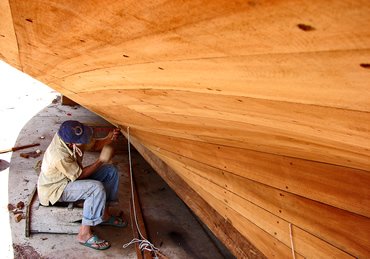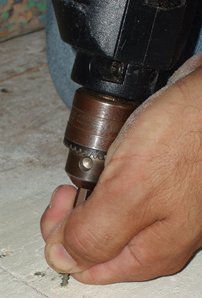4 Wooden Boat
Building Techniques

There are four basic wooden boat building construction techniques used by home boat builders. These are the stitch and tape, the ply on frame, the strip planking, and the clinker ply. Each has its own advantages and disadvantages.
Plans for 254 boats can be found by pressing
Click Here!
There always should be alternatives and here is another experinced boat builder with 518 plans and instructional CD's,
Click Here!
If you are a first time boat builder, then the stitch and tape method is one to choose. It’s also a good choice if you do not have a lot of wood working skills or time is limited on how long the construction phase can take.
You’ll find other important information below on the four main wooden boat building techniques so you can make the right choice for your next project.
Stitch and Tape
This is generally the fastest, easiest, and least expensive means of building a boat with a plywood hull. This construction method uses epoxy glue, “stitches,” and detailed cuts to create the hull. You don’t need any special tools or forms to use this method. It’s also called “stitch and tape” or “tack and tape.” This wooden boat building method became popular in the mid 1960’s with television’s first do-it-yourself expert.
The “stitching” of this type of boat building technique is done with wire, cable ties, or even duct tape. Copper wire is one of the most popular because it is suitable for a marine environment. After the stitches are in place, the area is glued with a thick epoxy and can be covered with fiberglass.
Ply on Frame
This method of wooden boat building starts with wooden frames, which are often called ribs.

There are frame members that are attached to slots in the ribs. The first one runs down the center and is called the keelson.
Two more frame members will run along the top on each side of the hull and are called sheer clams.
Finally, two additional frame members are attached where the bottom of the hull transitions into the sides of the hull. This joint is called the chine, while the frame member is called the chine log.
The joints are glued, screwed, or bolted and strong polyurethane adhesives are used to bond the joints. This type of boat building is strong and reliable when completed correctly.
Strip Planking
Strip planking is a type of cravel planking. The hull of the boat is built over forms by using strips of wood. These strips are narrow and because of that, there isn’t much shaping required. The edges are glued and fastened together.
Modern epoxy adhesives are used to hold the hull together, not the fasteners. This method is often used on small boats and canoes. There are many variations to strip planking and most woodworkers will tell you that this method is best suited for those with quite a bit of experience.
Clinker Ply
This method of constructing the hulls of boats is done by using wood planks in such a way that their edges overlap. The joint is called a “land.” This is an ancient form of wooden boat building, with the Vikings being the most successful in its application. They used wood planks and iron plates.
Today, the iron plates have gone by the wayside, but the method is still used with wood planks.
This method is also known as Lapstrake. A boat crafted from this construction technique is lighter and it tends to move more efficiently. This is due to less water being displaced to the sides while moving. Obviously, this type of boat building will take a lot of knowledge about the clinker ply or lapstrake method, but the results are quite exceptional.
Another boat plan supplier who have focused their plans towards the unskilled is Gator Boat Plans, 8 types where you might find a plan to suit your needs.
Back to Boat Building
Return to Woodworking from Wooden Boat Building